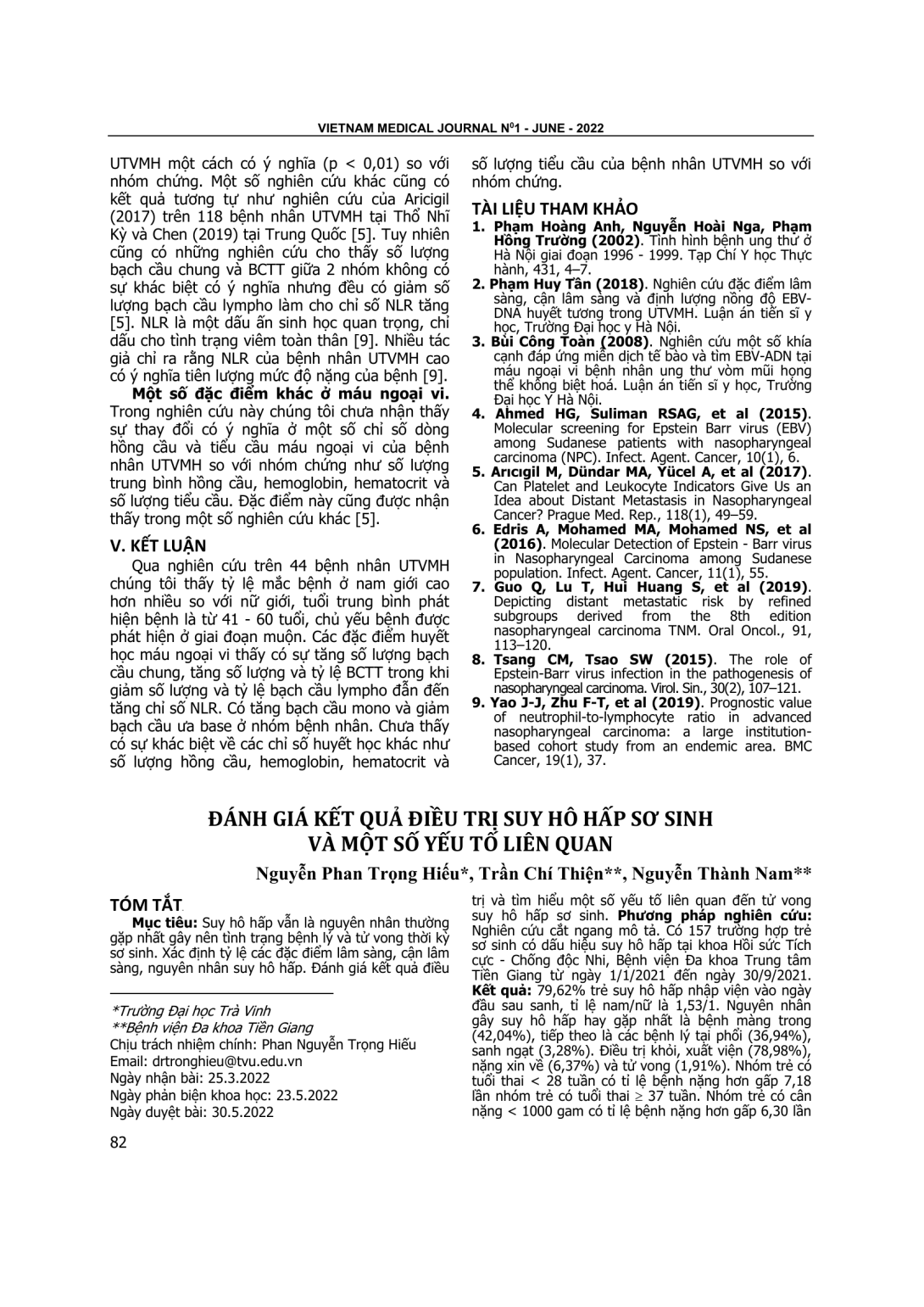
Suy hô hấp vẫn là nguyên nhân thường gặp nhất gây nên tình trạng bệnh lý và tử vong thời kỳ sơ sinh. Xác định tỷ lệ các đặc điểm lâm sàng, cận lâm sàng, nguyên nhân suy hô hấp. Đánh giá kết quả điều trị và tìm hiểu một số yếu tố liên quan đến tử vong suy hô hấp sơ sinh. Phương pháp nghiên cứu: Nghiên cứu cắt ngang mô tả. Có 157 trường hợp trẻ sơ sinh có dấu hiệu suy hô hấp tại khoa Hồi sức Tích cực - Chống độc Nhi, Bệnh viện Đa khoa Trung tâm Tiền Giang từ ngày 1/1/2021 đến ngày 30/9/2021. Kết quả: 79,62% trẻ suy hô hấp nhập viện vào ngày đầu sau sanh, tỉ lệ nam/nữ là 1,53/1. Nguyên nhân gây suy hô hấp hay gặp nhất là bệnh màng trong (42,04%), tiếp theo là các bệnh lý tại phổi (36,94%), sanh ngạt (3,28%). Điều trị khỏi, xuất viện (78,98%), nặng xin về (6,37%) và tử vong (1,91%). Nhóm trẻ có tuổi thai < 28 tuần có tỉ lệ bệnh nặng hơn gấp 7,18 lần nhóm trẻ có tuổi thai 37 tuần. Nhóm trẻ có cân nặng < 1000 gam có tỉ lệ bệnh nặng hơn gấp 6,30 lần nhóm trẻ có cân nặng 2500 gam. So với nhóm trẻ có điểm silverman ≤ 3 điểm, nhóm trẻ có điểm silverman > 6 điểm có tỉ lệ bệnh nặng hơn gấp 16,00 lần. Nhóm trẻ có thở máy tỉ lệ bệnh nặng gấp 6,23 lần nhóm trẻ thở oxy, sự khác biệt có ý nghĩa thống kê, p < 0,001. Kết luận: Cần quan tâm công tác quản lý thai kỳ, đặt biệt là các sản phụ có nguy cơ cao. Tăng cường các kỹ năng hồi sức sơ sinh cho các y bác sĩ tuyến huyện, tuyến xã. Phát hiện sớm và điều trị kịp thời các nguyên nhân gây sinh non, suy dinh dưỡng bào thai, suy thai, ngạt chu sinh
Respiratory failure remains the most common cause of neonatal morbidity and mortality. Determine the ratio of clinical, subclinical characteristics, causes of respiratory failure. Evaluate treatment outcomes and learn some factors related to neonatal respiratory failure mortality. Methods: escriptive cross-sectional study. There were 157 newborns showing signs of respiratory failure at the Intensive Care Unit Children of Tien Giang Central General Hospital, from January 1, 2021, to September 30, 2021. Results: 79.62% of children with respiratory failure were hospitalized on the first day after birth; the male/female ratio was 1.53/1. The most common cause of respiratory failure was neonatal respiratory distress syndrome (42.04%), followed by lung diseases (36.94%), asphyxia (3.28%). The treatment was cured, discharged from the hospital (78.98%), severe enough to die (6.37%), and died (1.91%). The group of children with a gestational age of fewer than 28 weeks has a 7.18 times higher rate of severe disease than children with a gestational age of 37 weeks. The group of children with weight < 1000 grams had a rate of severe disease 6.30 times higher than the group of children with weight 2500 grams. Compared with the group of children with Silverman score ≤ 3 points, the group with Silverman score > 6 points had a 16.00 times higher rate of severe disease. The group of children with mechanical ventilation had a rate of severe disease 6.23 times higher than that of children receiving oxygen; the difference was statistically significant, p < 0.001. Conclusions: Care should be taken in the management of pregnancy, especially in high-risk women. Strengthening neonatal resuscitation skills for district and commune health workers. Early detection and timely treatment of causes of premature birth, fetal malnutrition, fetal distress, perinatal asphyxia.
- Đăng nhập để gửi ý kiến
